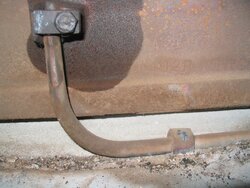I have a VC Defiant Encore purchased new in March 1991, which I assume is a model 2140. Over the last year, the damper has become increasingly difficult to close; I start moving the lever and it jams before moving very far. If I jiggle the handle back and forth, eventually the jam releases and the damper can be fully closed and locked. Lately the jam seems more difficult to clear and extends through a wider range of handle motion.
The damper opens up just fine.
The damper gasket looks fine and does not appear to be getting in the way. After removing the flue collar, visual inspection of the two side damper tabs shows them to be unbroken and straight. The damper tab over the torsion rod also appears to be unbroken and straight, but the end of the torsion rod that goes under the tab has a linear area that is scraped clean with contact with the underside of the damper tab.
I don't know if the "scraped clean" area is indicative of too much friction or how I would remedy it if it was.
What else can I check to try and find what is causing this issue?
FWIW: I have removed and replaced all easily accessible gaskets at least twice over the period of ownership, the catalytic converter multiple times, and replaced the inside cast iron fireback about 15 years ago that warped due to (I assume) over-firing by a first-time woodstove owner (me).
Thanks.
The damper opens up just fine.
The damper gasket looks fine and does not appear to be getting in the way. After removing the flue collar, visual inspection of the two side damper tabs shows them to be unbroken and straight. The damper tab over the torsion rod also appears to be unbroken and straight, but the end of the torsion rod that goes under the tab has a linear area that is scraped clean with contact with the underside of the damper tab.
I don't know if the "scraped clean" area is indicative of too much friction or how I would remedy it if it was.
What else can I check to try and find what is causing this issue?
FWIW: I have removed and replaced all easily accessible gaskets at least twice over the period of ownership, the catalytic converter multiple times, and replaced the inside cast iron fireback about 15 years ago that warped due to (I assume) over-firing by a first-time woodstove owner (me).
Thanks.



 ! Leaving that piece of material;l in there isn't the end of the world, but damaging the refractory sure is.
! Leaving that piece of material;l in there isn't the end of the world, but damaging the refractory sure is.